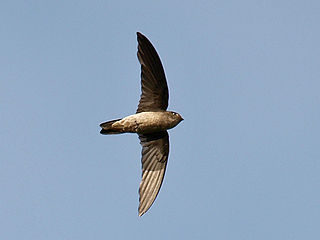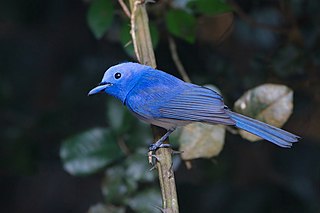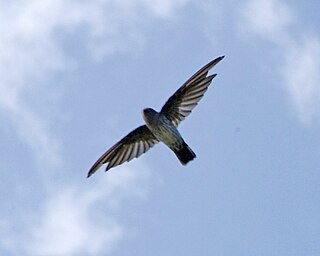
Swiftlets are birds contained within the four genera Aerodramus, Hydrochous, Schoutedenapus and Collocalia. They form the Collocaliini tribe within the swift family Apodidae. The group contains around thirty species mostly confined to southern Asia, south Pacific islands, and northeastern Australia, all within the tropical and subtropical regions. They are in many respects typical members of the Apodidae, having narrow wings for fast flight, with a wide gape and small reduced beak surrounded by bristles for catching insects in flight. What distinguishes many but not all species from other swifts and indeed almost all other birds is their ability to use a simple but effective form of echolocation to navigate in total darkness through the chasms and shafts of the caves where they roost at night and breed. The nests of some species are built entirely from threads of their saliva, and are collected for the famous Chinese delicacy bird's nest soup.

Aerodramus is a genus of small, dark, cave-nesting birds in the Collocaliini tribe of the swift family. Its members are confined to tropical and subtropical regions in southern Asia, Oceania and northeastern Australia. Many of its members were formerly classified in Collocalia, but were first placed in a separate genus by American ornithologist Harry Church Oberholser in 1906.

The black-naped monarch or black-naped blue flycatcher is a slim and agile passerine bird belonging to the family of monarch flycatchers found in southern and south-eastern Asia. They are sexually dimorphic, with the male having a distinctive black patch on the back of the head and a narrow black half collar ("necklace"), while the female is duller with olive brown wings and lacking the black markings on the head. They have a call that is similar to that of the Asian paradise flycatcher, and in tropical forest habitats, pairs may join mixed-species foraging flocks. Populations differ slightly in plumage colour and sizes.

The edible-nest swiftlet, also known as the white-nest swiftlet, is a small bird of the swift family which is found in South-East Asia. Its opaque and whitish bird nest is made exclusively of solidified saliva and is the main ingredient of bird's nest soup, a delicacy of Chinese cuisine.
The Ameline swiftlet, also known as the grey swiftlet, was formerly considered as a subspecies of the uniform swiftlet. It is endemic to the Philippines. Its natural habitat is subtropical or tropical moist lowland forests. Despite some fears around conservation, the species remains a Least-concern species.

Collocalia is a genus of swifts, containing some of the smaller species termed "swiftlets". Formerly a catch-all genus for these, a number of its former members are now normally placed in Aerodramus.

The glossy swiftlet is a species of swift in the family Apodidae. It is found on the Indonesian island of Sulawesi and eastwards to New Guinea, the Bismarck Archipelago and the Solomon Islands.

The Mascarene swiftlet is a species of swift in the family Apodidae. It is found in Mauritius and Réunion, and the populations on the two islands have recently been confirmed to differ subspecifically. The nominate race francicus is found on Mauritius and the recently described race saffordi occurs on Réunion. Its natural habitats are subtropical or tropical moist lowland forest, subtropical or tropical high-altitude shrubland, subtropical or tropical high-altitude grassland, caves, arable land, and heavily degraded former forest. It is threatened by habitat loss.

The cave swiftlet is a species of swift in the family Apodidae. It is found on the Indonesia islands of Sumatra, Java and Bali. It is a woodland species and nests in caves. The Bornean swiftlet was considered a subspecies, but is now usually considered distinct.

The thick-billed green pigeon is a species of bird in the family Columbidae.

The green iora is a species of bird in the family Aegithinidae. It is found in the Thai-Malay Peninsula, Sumatra and Borneo. Its habitats include lowland forests, secondary forest and mangrove forest. It is threatened by habitat loss, and the International Union for Conservation of Nature (IUCN) has assessed it as near-threatened.
The Christmas Island swiftlet, also known as the Christmas glossy swiftlet or the Christmas cave swiftlet, is a small bird in the swift family Apodidae. It is endemic to Christmas Island, an Australian territory in the eastern Indian Ocean. It was formerly commonly treated as a subspecies of the glossy swiftlet.
The Bornean swiftlet, also referred to as the Kinabalu 'linchi' swiftlet, is a small bird in the swift family Apodidae. It is endemic to the northern mountains of the island of Borneo. It has variously been considered a subspecies of the glossy swiftlet or the cave swiftlet, and in 2008 was split from the latter as a full species C. dodgei.

The grey-rumped swiftlet or grey-rumped swiftlet, is a small bird in the swift family Apodidae. It is endemic to some islands in the Philippines.

The Apodinae are a subfamily of swifts and contain the following species:
The satin swiftlet is a small bird in the swift family Apodidae. It is endemic to the Santa Cruz Islands, Vanuatu, New Caledonia and the Loyalty Islands in the southwestern Pacific Ocean. It was formerly treated as a subspecies of the glossy swiftlet.
The drab swiftlet is a small bird in the swift family Apodidae. It is endemic to the Lesser Sunda Islands in Indonesia. It was formerly treated as a subspecies of the glossy swiftlet.

The ridgetop swiftlet is a small bird in the swift family Apodidae. It is endemic to the Philippines.
The Tenggara swiftlet is a small bird in the swift family Apodidae. It is endemic to the western Lesser Sunda Islands of Indonesia.















